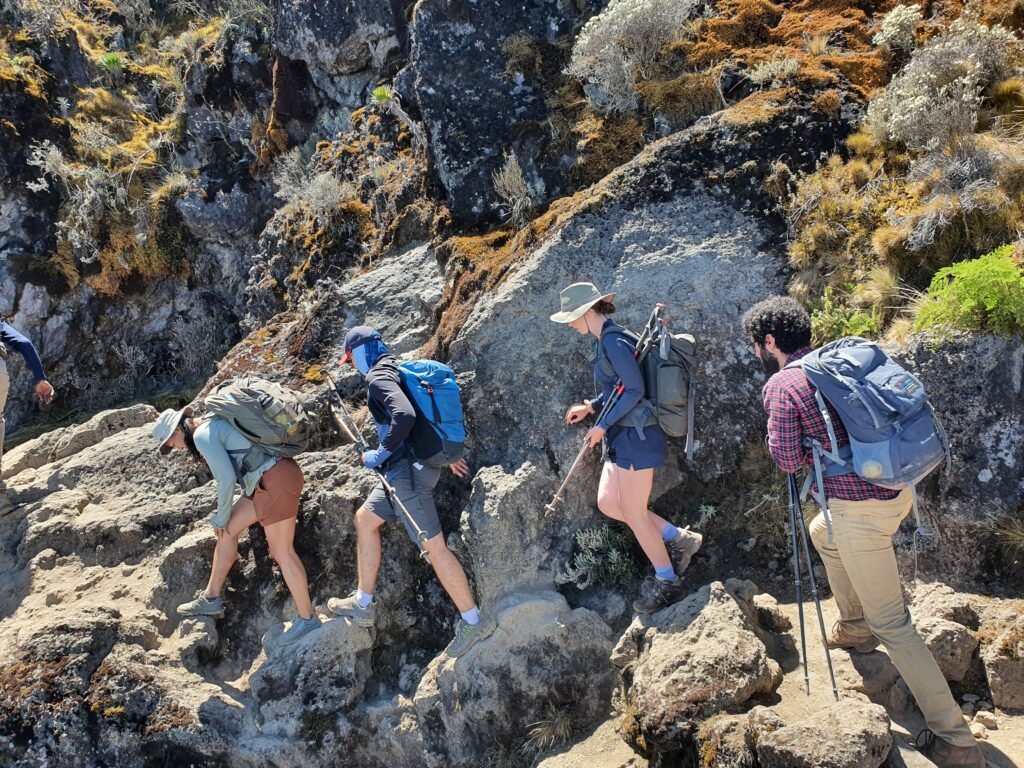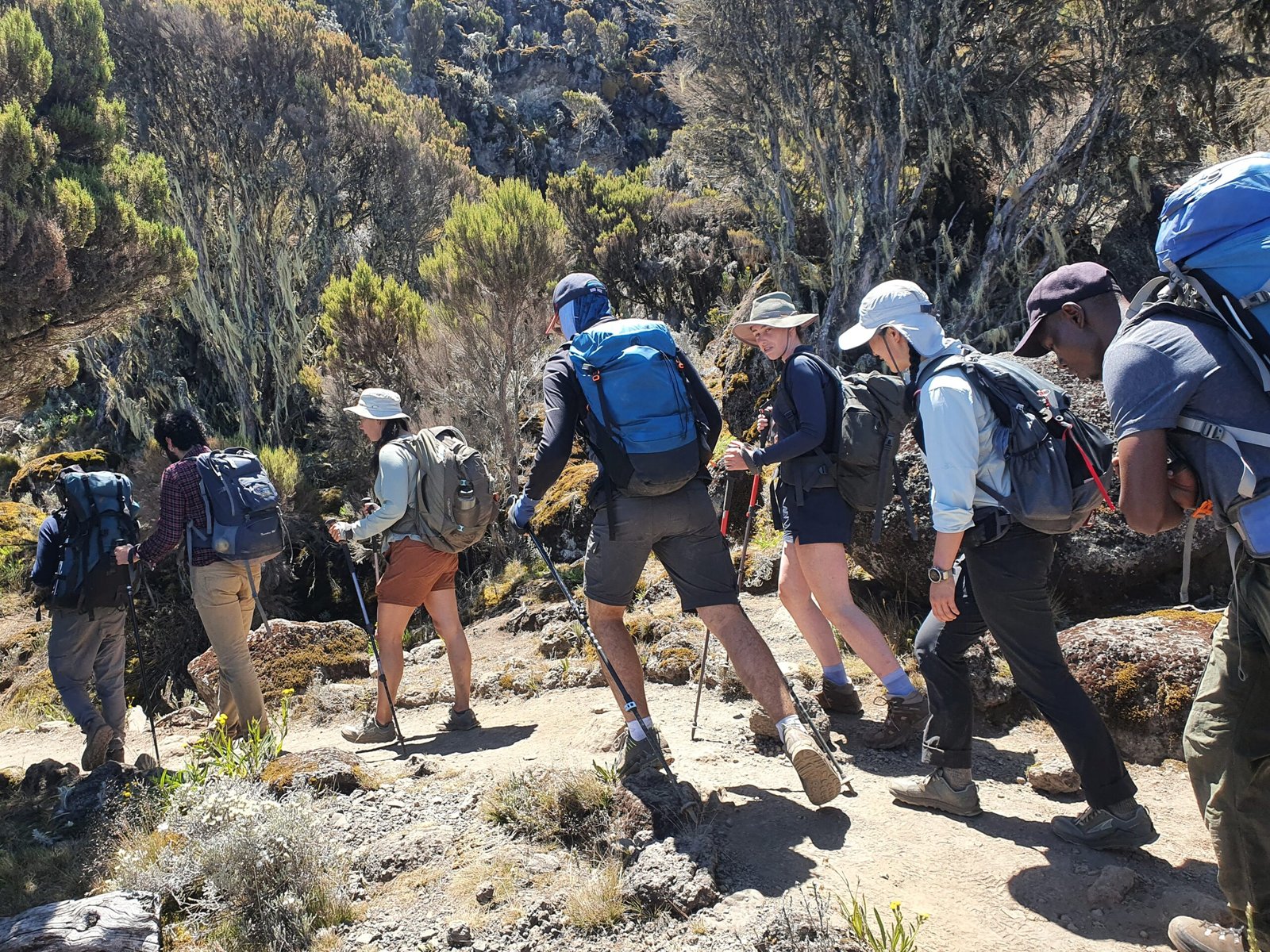Why Choose the Marangu Route for Your Kilimanjaro Climb? A Full Guide with Itinerary-2025
Why Choose the Marangu Route for Your Kilimanjaro Climb? A Full Guide with Itinerary
The Marangu Route, often called the “Coca-Cola Route,” is one of the most popular and straightforward ways to reach the summit of Mount Kilimanjaro. Known for its well-maintained trail, hut accommodations, and easier gradients, it is an ideal route for beginner climbers or those seeking a comfortable trekking experience.

In this guide, we’ll explore the key reasons to choose the Marangu Route for your Kilimanjaro adventure and provide a detailed 6-day itinerary to help you prepare for the journey of a lifetime.
Why Choose the Marangu Route?
Easiest Route to the Summit
The Marangu Route is widely regarded as the easiest and most direct path to the summit of Mount Kilimanjaro. The gradual ascent and moderate terrain make it more manageable for beginners or trekkers looking for a less physically demanding climb. While the climb still requires stamina and perseverance, the trail has fewer steep sections compared to other routes like Machame or Lemosho.
Hut Accommodations for Comfort
Unlike other routes where trekkers camp in tents, the Marangu Route provides hut accommodations at each stop. These communal huts are equipped with beds and mattresses, offering shelter and more comfort, especially during cold nights at higher altitudes. The huts also have shared dining areas, making them a social experience where you can interact with other climbers.
Shorter Duration
The Marangu Route can be completed in 5-6 days, making it one of the shortest routes to the summit. For climbers with limited time, this is an attractive option, as you’ll spend fewer days on the mountain while still having a high chance of summiting, especially with an additional acclimatization day.
Well-Maintained Path
The Marangu Route is well-marked and well-maintained, ensuring a safe and reliable trail throughout the climb. The paths are easy to follow, with minimal scrambling or technical climbing required. This makes the route perfect for first-time climbers or those who want a straightforward trekking experience.
Diverse Ecosystems
Despite being one of the easier routes, the Marangu Route takes you through Kilimanjaro’s diverse ecosystems. Starting in the lush rainforest zone, the trail leads you through moorlands, alpine deserts, and ultimately to the arctic zone at the summit. Each day offers new landscapes, from tropical jungles to barren, rocky highlands, creating a visually stimulating journey to the top.
Great for Solo Climbers or Groups
The shared huts make the Marangu Route a great choice for solo climbers or those traveling in groups. The communal dining areas and accommodations foster a social atmosphere where you can meet fellow trekkers and share experiences, adding to the overall adventure.
6-Day Marangu Route Itinerary
Day 1: Arrival in Moshi
Arrival in Tanzania: Arrive at Kilimanjaro International Airport and transfer to your hotel in Moshi.
Pre-Climb Briefing: Meet your guide for a pre-trek briefing, gear check, and review of the climb schedule.
Overnight Stay: Relax and prepare for the climb at a comfortable hotel in Moshi.
Day 2: Marangu Gate (1,870m) to Mandara Hut (2,720m)
Distance: 8 km (5 miles)
Hiking Time: 5-6 hours
Terrain: Rainforest
Altitude Gain: 850m
After breakfast, drive to Marangu Gate to begin the trek. Complete registration and enter the lush rainforest zone, where you may spot colobus monkeys and other wildlife. The trail is well-shaded with vibrant green scenery and rich vegetation. Arrive at Mandara Hut in the afternoon, where you can take a short optional hike to Maundi Crater for views of northern Tanzania and Kenya.
Overnight: Mandara Hut
Day 3: Mandara Hut (2,720m) to Horombo Hut (3,720m)
Distance: 12 km (7.5 miles)
Hiking Time: 6-8 hours
Terrain: Heath and Moorland
Altitude Gain: 1,000m
Continue through the heather and moorland zone, where the landscape opens up and the air becomes cooler and drier. As you ascend, you’ll catch your first glimpses of Kibo and Mawenzi Peaks, two of Kilimanjaro’s iconic summits. The trek is steady and gradual, allowing you to acclimatize as you progress. Arrive at Horombo Hut in the late afternoon, where you’ll spend the night.
Overnight: Horombo Hut
Day 4: Acclimatization Day at Horombo Hut
Optional Acclimatization Hike: To Zebra Rocks (4,000m)
Hiking Time: 2-3 hours (optional)
To improve your chances of successfully reaching the summit, spend an additional day at Horombo Hut for acclimatization. You can opt for a short hike to Zebra Rocks, a striking rock formation with distinct black-and-white stripes, to help adjust to the altitude. Rest and prepare for the next day’s ascent.
Overnight: Horombo Hut
Day 5: Horombo Hut (3,720m) to Kibo Hut (4,703m)
Distance: 10 km (6 miles)
Hiking Time: 6-8 hours
Terrain: Alpine Desert
Altitude Gain: 983m
Trek across the vast and barren Saddle between Kibo and Mawenzi, where the landscape becomes more desolate and rugged. The altitude is noticeable as you approach Kibo Hut, your base for the final summit push. Arrive at Kibo Hut in the afternoon, where you’ll have an early dinner and rest, as the summit attempt begins at midnight.
Overnight: Kibo Hut
Day 6: Kibo Hut to Uhuru Peak (5,895m) to Horombo Hut
Distance: 20 km (12.5 miles) (6 km ascent, 14 km descent)
Hiking Time: 10-14 hours
Terrain: Arctic Summit Zone, Alpine Desert
Altitude Gain: 1,192m (to Uhuru Peak)
Descent: 2,175m (to Horombo Hut)
Summit Day: Start the trek at midnight, ascending the steep, rocky path to Gilman’s Point (5,681m), located on the crater rim. From there, continue to Uhuru Peak, the highest point in Africa. The trek is challenging due to the high altitude and cold temperatures, but the sight of the sunrise at the summit is unforgettable. After celebrating your achievement, descend back to Kibo Hut for a short rest, and then continue down to Horombo Hut for the night.
Overnight: Horombo Hut
Day 7: Horombo Hut (3,720m) to Marangu Gate (1,870m)
Distance: 20 km (12.5 miles)
Hiking Time: 5-7 hours
Terrain: Moorland and Rainforest
On your final day, trek back down through the moorland and rainforest to Marangu Gate, where you’ll receive your Kilimanjaro summit certificate. After saying farewell to your trekking team, transfer back to Moshi for a well-deserved rest.
Overnight: Hotel in Moshi
Day 8: Departure
Transfer: After breakfast, transfer to Kilimanjaro International Airport for your flight home or continue with other travel plans.
Is the Marangu Route Right for You?
The Marangu Route is the best choice for:
Beginner climbers: Its gradual ascent and shorter duration make it suitable for those new to high-altitude trekking.
Comfort seekers: Hut accommodations offer more shelter and warmth than tents, providing a more comfortable climb.
Solo or group travelers: The communal huts foster a social atmosphere where trekkers can interact and share experiences.
Time-conscious adventurers: With a 6-day duration, the Marangu Route is ideal for those with limited time.
Conclusion
The Marangu Route offers a balanced Kilimanjaro climbing experience, blending comfort, scenic beauty, and a manageable trekking challenge. Whether you’re new to trekking or looking for a well-supported journey to the Roof of Africa, this route provides an ideal introduction to the world’s highest freestanding mountain.
Package Inclusion & Exclusions
Inclusion
- Guide, Porters
- Park Fees, Tax
- Gate transfer
- Crew wages
- Environment fees
- During the climb you will be camping throughout you climb!
- Breakfasts, Lunches, Dinners
- Drinking water
- Cook
Exclusion
- Flights
- Tipping the crew
- Visas

